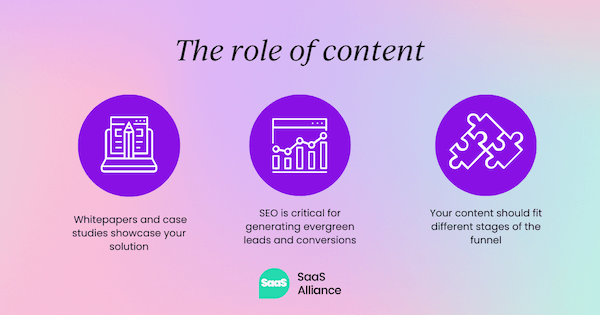Editor’s note: This article is based on an interview conducted with Bolaji by PMA (the sister community of SaaS alliance) scholar Emmanuel Nwosu.
My name is Bolaji Anifowose, Head of Partner Marketing at Distrobird and former Head of Marketing at Simpu. Over the years, I’ve had the privilege of launching and marketing several SaaS products, learning invaluable lessons along the way. In this article, I will share insights from my experience, offering a roadmap for creating a successful Go-to-Market (GTM) strategy, driving revenue, and utilizing content marketing for growth.
Measuring the effectiveness of a go-to-market strategy
A GTM strategy encompasses all activities, people, and efforts involved in bringing a product to market. To ensure success, you need to create a robust GTM theme, model, and choose the right channels.
A critical aspect is setting metrics to measure success. While these metrics may vary based on your business model, they should ultimately lead to revenue generation, the driving force behind any successful business.
For product-led SaaS businesses, key metrics include product sign-ups, feature usage, and churn rate, reflecting product adoption and potential revenue. For sales-led companies, success metrics include Marketing Qualified Leads (MQLs) generated for the sales team and the win-rate of sales enablement materials used.
To track these metrics effectively, set up a comprehensive analytics dashboard using tools like Amplitude, Mixpanel, or June.so, and monitor revenue metrics through a tool like ProfitWell.
Content marketing's role in GTM strategy
Content is at the heart of any GTM strategy, essential for nailing positioning and messaging. It can take many forms—blogs, whitepapers, videos, case studies, and ebooks—and should be aligned with your company's growth goals.
For sales-led companies, case studies play a crucial role in boosting sales velocity, showing how your product has helped others achieve their goals. SEO also remains an essential channel, offering evergreen leads and conversions. I recommend creating content that caters to different funnel stages. For example, bottom-of-the-funnel (BOFU) content like comparisons or how-to guides can help convert problem-aware leads into customers.
Events, thought leadership webinars, and other video content types can generate MQLs and SQLs, contributing to a comprehensive content strategy.

Challenges in GTM launches
Budget constraints have been a significant challenge for me in launching SaaS products, limiting my options for channels. I had to make trade-offs, focusing on channels with higher ROI. Unclear target audience, team alignment and pricing strategy are other crucial aspects. Establishing a pricing strategy early on is vital to avoid post-launch struggles, and constant customer feedback is essential to refine it.
Pricing for adoption
My experience at Simpu showed the drawbacks of a freemium model, leading to many unqualified leads and skewed data. We adjusted to a 14-day free trial, allowing users to explore and decide if they'd pay.
Knowing your Ideal Customer Profile (ICP) through research and constant feedback helps set an appropriate pricing strategy, ensuring your target market's needs are met. Unless absolutely necessary or for a well-funded hobby project, I generally avoid offering a freemium model.
SaaS companies need to be very strategic if they choose to implement it. By adjusting to a 14-day free trial period, I believe we give users enough time to explore our product and decide if they find enough value to convert to a paid account.
A mistake that many new SaaS companies make is that they undervalue their product. Show conviction. If you know your product is great, price it accordingly. Because if you end up with a high volume of free users later down the line, it can create major problems for you.
Final thoughts: Nail your ICP
It's critical to accurately define your ideal customer profile (ICP). Initially, we faced a challenge in this area. Our first users were technology enthusiasts and hobbyists excited about trying new SaaS tools, but they didn't necessarily need the solutions we provided.
For any SaaS company, this is a precarious position, as it can hinder your growth by preventing you from receiving valuable feedback from your target customers. Instead, focus on individuals who genuinely need your solutions to their problems and are prepared to invest significantly to solve them.
This understanding of your ICP should then inform your pricing strategy. Before your GTM launch, you should have conducted customer surveys and interviews—particularly with your ICPs—to establish an appropriate price point for your key audience.
Moreover, maintain ongoing dialogues with your customers to keep tabs on their changing behaviors, reactions, and opinions about your pricing. Use this information to adjust your strategy, ensuring your pricing aligns with the scale of your customers’ businesses, whether they are small businesses or larger enterprises.
Like what you see? Why not soak up exclusive insights from some of the leading minds in SaaS with a SaaS Alliance membership plan?


